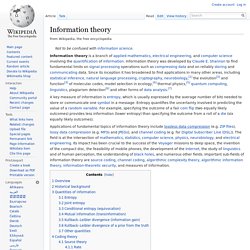

Sixty-Four Scenes from Saturn ... The Poster. "zum Thema:" Die Landlosen der Cyberwelt. Pi to 1,000,000 places. 24_6902_0_junk.pdf (application/pdf Object) Cray-1. Cray-1 with internals exposed at EPFL The Cray-1 was a supercomputer designed, manufactured and marketed by Cray Research.

The first Cray-1 system was installed at Los Alamos National Laboratory in 1976 and it went on to become one of the best known and most successful supercomputers in history. The Cray-1's architect was Seymour Cray, the chief engineer was Cray Research co-founder Lester Davis.[1] History[edit] Jim Thornton, formerly Cray's engineering partner on earlier designs, had started a more radical project known as the CDC STAR-100.
As a result, Cray left CDC and started a new company HQ only yards from the CDC lab. In 1975 the 80 MHz Cray-1 was announced. The 80 MFLOPS Cray-1 was succeeded in 1982 by the 800 MFLOPS Cray X-MP, the first Cray multi-processing computer. Background[edit] Typical scientific workloads consist of reading in large data sets, transforming them in some way and then writing them back out again. Vector machines[edit] The real savings are not so obvious. Define Cybernetics at Dictionary. Cybernetics. Cybernetics is a transdisciplinary[1] approach for exploring regulatory systems, their structures, constraints, and possibilities.

Cybernetics is relevant to the study of systems, such as mechanical, physical, biological, cognitive, and social systems. Cybernetics is applicable when a system being analyzed incorporates a closed signaling loop; that is, where action by the system generates some change in its environment and that change is reflected in that system in some manner (feedback) that triggers a system change, originally referred to as a "circular causal" relationship. Some say this is necessary to a cybernetic perspective. System dynamics, a related field, originated with applications of electrical engineering control theory to other kinds of simulation models (especially business systems) by Jay Forrester at MIT in the 1950s. Norbert Wiener defined cybernetics in 1948 as "the scientific study of control and communication in the animal and the machine Definitions[edit] W. General. Decision theory.
Normative and descriptive decision theory[edit] Since people usually do not behave in ways consistent with axiomatic rules, often their own, leading to violations of optimality, there is a related area of study, called a positive or descriptive discipline, attempting to describe what people will actually do.

Since the normative, optimal decision often creates hypotheses for testing against actual behaviour, the two fields are closely linked. Furthermore it is possible to relax the assumptions of perfect information, rationality and so forth in various ways, and produce a series of different prescriptions or predictions about behaviour, allowing for further tests of the kind of decision-making that occurs in practice. In recent decades, there has been increasing interest in what is sometimes called 'behavioral decision theory' and this has contributed to a re-evaluation of what rational decision-making requires.[1]
Information theory. Overview[edit] The main concepts of information theory can be grasped by considering the most widespread means of human communication: language.

Two important aspects of a concise language are as follows: First, the most common words (e.g., "a", "the", "I") should be shorter than less common words (e.g., "roundabout", "generation", "mediocre"), so that sentences will not be too long. Such a tradeoff in word length is analogous to data compression and is the essential aspect of source coding. Second, if part of a sentence is unheard or misheard due to noise — e.g., a passing car — the listener should still be able to glean the meaning of the underlying message. Such robustness is as essential for an electronic communication system as it is for a language; properly building such robustness into communications is done by channel coding. Note that these concerns have nothing to do with the importance of messages. Historical background[edit] With it came the ideas of This is justified because.
Forked from: パーティクル崩し.